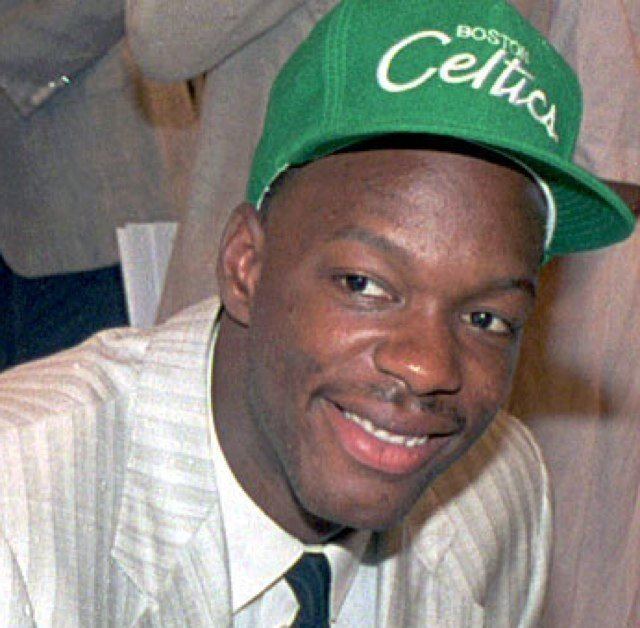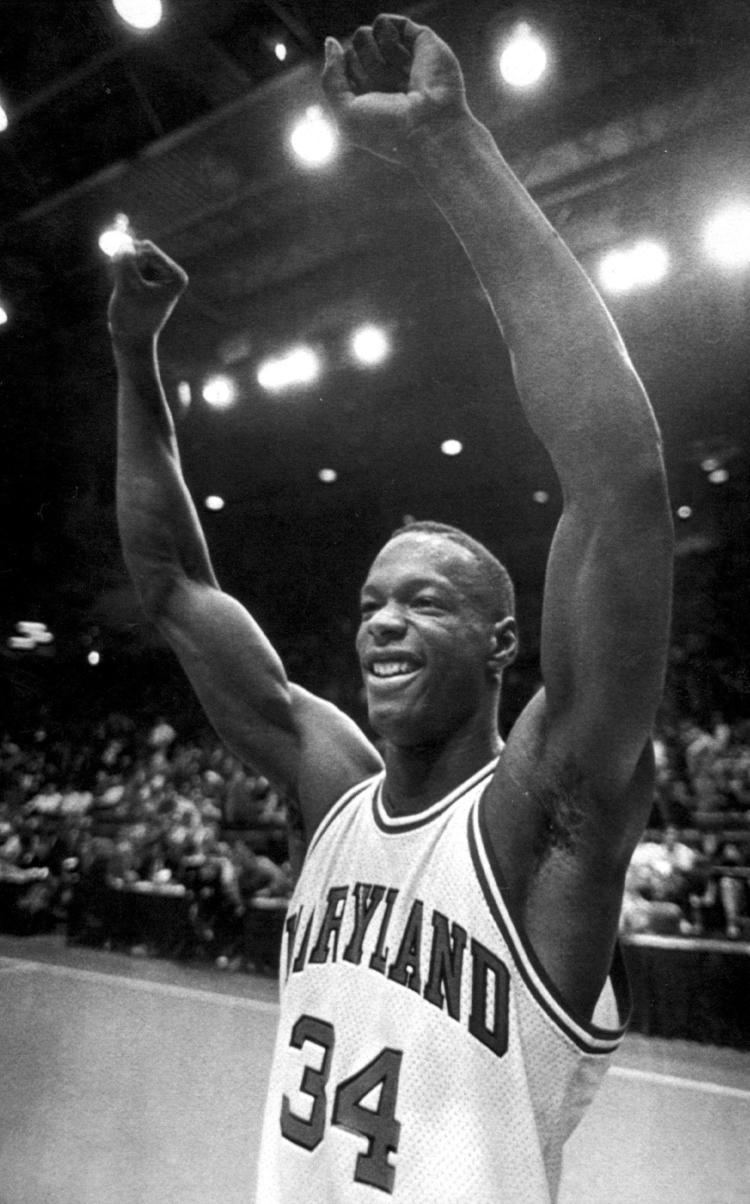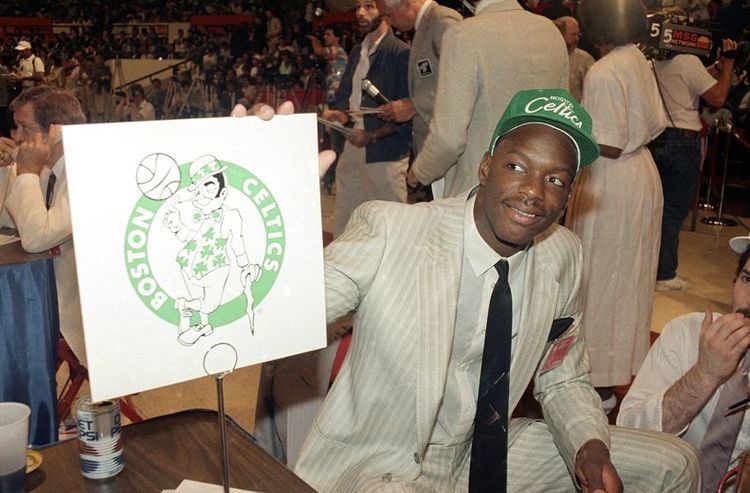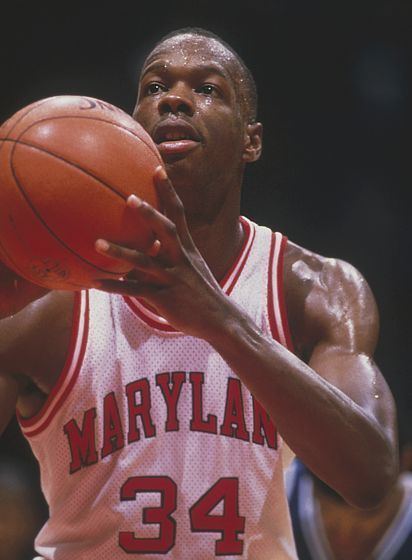Nationality American Name Len Bias Listed height 6 ft 8 in (2.03 m) Role Basketball player | Listed weight 210 lb (95 kg) Height 2.03 m Siblings Eric Bias | |
 | ||
Similar People Reggie Lewis, Hank Gathers, Lefty Driesell, Ben Wilson, Kirk Fraser | ||
Len bias vs david robinson ncaa 1985 maryland vs navy
Leonard Kevin Bias (November 18, 1963 – June 19, 1986) was a first-team All-American college basketball forward at the University of Maryland. He was selected by the Boston Celtics as the second overall pick in the 1986 NBA draft on June 17, and died two days later from cardiac arrhythmia induced by a cocaine overdose. He is considered by some sportswriters to be the greatest player not to play at the professional level.
Contents
- Len bias vs david robinson ncaa 1985 maryland vs navy
- 1986 nba draft len bias
- Early years
- College career
- NBA selection and overdose
- Trial
- University of Maryland
- Jay Bias
- Parents
- Films
- References

1986 nba draft len bias
Early years

Bias was born and raised in the Maryland suburbs of Washington, D.C.. He was known to friends and family as "Frosty", a nickname he received from his pastor because of his cool demeanor.

Bias was one of four children born to James Bias, Jr. and Dr. Lonise Bias. He had a sister, Michelle, and two brothers, Eric and James III, known as "Jay".
College career

From Landover, Maryland, Bias graduated from Northwestern High School in Hyattsville, Maryland, and subsequently attended the University of Maryland.
As a freshman, he was viewed as "raw and undisciplined", but developed himself over time into an All-American player. In his junior year, he led the Atlantic Coast Conference in scoring and was named the ACC's Player of the Year. His senior season was highlighted by his performance in an overtime victory against top-ranked North Carolina in which he scored 35 points, including 7 in the last 3 minutes of regulation and 4 in overtime. At the end of the year, Bias collected his second ACC Player of the Year award and was named to two All-America teams.
Bias impressed basketball fans with his amazing leaping ability, his physical stature and his ability to create plays, and was considered one of the most dynamic players in the nation. By his senior year, scouts from various National Basketball Association teams viewed Bias as the most complete forward in the Class of 1986. According to Celtics scout Ed Badger, "He's maybe the closest thing to (Chicago guard) Michael Jordan to come out in a long time. I'm not saying he's as good as Michael Jordan, but he's an explosive and exciting kind of player like that." Jordan was then in his second professional season with the Chicago Bulls.
NBA selection and overdose
On Tuesday, June 17, Bias was selected by the defending NBA champion Celtics as the second overall pick in the 1986 NBA draft, which was held in New York City at Madison Square Garden. Arnold "Red" Auerbach, as the Boston Celtics president and general manager, had previously dealt guard Gerald Henderson and cash to the Seattle SuperSonics for the pick in 1984. After the draft, Bias and his family returned to their suburban Maryland home.
On Wednesday, June 18, Bias and his father flew to Boston, Massachusetts, from Washington, D.C., for an NBA club draft acceptance and product endorsement signing ceremony with the Celtics' coaches and management. Bias had discussions with Reebok's sports marketing division regarding a five-year endorsement package worth $1.6 million.
After returning home to Maryland, Bias retrieved his newly leased sports car and drove back to his room on the campus of the University of Maryland. He then dined with some teammates and a member of the football team. He left campus at approximately 2 a.m. on Thursday, June 19 and drove to an off-campus gathering, which he attended briefly before returning to his dorm in Washington Hall sometime between 2:30 and 3 a.m. For the next three to four hours, Bias, longtime friend Brian Tribble and several teammates repeatedly insufflated cocaine in the dormitory suite shared by Bias and his teammates. According to the campus timeline, Bias had a seizure and collapsed some time between 6:25 and 6:32 a.m. while talking with teammate Terry Long. At 6:32 a.m., when the 911 call to Prince George's County emergency services was made by Tribble, Bias was unconscious and not breathing. All attempts by the emergency medical team to restart his heart and breathing were unsuccessful. After additional attempts to revive him at Leland Memorial Hospital in Riverdale, Maryland, Bias was pronounced dead at 8:55 a.m. of a cardiac arrhythmia related to usage of cocaine. It was reported that there were no other drugs or alcohol found in his system after his death.
Four days after Bias died, on June 23, more than 11,000 people attended a memorial service at the Cole Field House, the university recreation and student center where Bias played for the Terrapins. Those speaking at the service included Red Auerbach, who said he had planned for three years to draft Bias for the Celtics. Auerbach added that the city of Boston had not been so shocked since the assassination of John F. Kennedy. On June 30, 1986, the Celtics honored Bias with their own memorial service, giving his never-used #30 Celtics jersey to his mother, Lonise.
Bias was interred at Lincoln Memorial Cemetery in Suitland, Maryland.
Trial
On July 25, 1986, a grand jury returned indictments against Bias's friend Brian Tribble for possession of cocaine and possession of cocaine with intent to distribute. Bias's Maryland teammates Terry Long and David Gregg were charged with possession of cocaine and obstruction of justice. Long and Gregg were both suspended from the team on July 31. All three defendants entered not guilty pleas in August.
On October 20, 1986, prosecutors dropped all charges against Long and Gregg in exchange for their testimony against Tribble. On October 30, the grand jury added three more indictments against Tribble—one count of conspiracy to obstruct justice and two counts of obstruction of justice.
Also on October 30, Kenneth Mark Fobbs, Tribble's roommate, was charged with perjury for allegedly lying to the grand jury about the last time he had seen Tribble. The state ultimately dropped the perjury charges against Fobbs on March 24, 1987, and a jury acquitted Tribble of all charges related to the Bias case on June 3, 1987.
In October 1990, following a two-year undercover sting operation, Tribble pleaded guilty to a drug charge. He cooperated with the government and was sentenced to ten years and one month of confinement.
U.S. Congress passed the Anti-Drug Abuse Act of 1988, often known as "The Len Bias Law." It was backed by both parties, reinforced the War on Drugs with stiffer penalties and expanded the DARE program.
University of Maryland
The circumstances surrounding Bias's death threw the University of Maryland and its athletics program into turmoil. An investigation revealed that Bias was 21 credits short of the graduation requirement despite having attended the university for four full years; in his final semester he had earned no academic credits at all, failing three courses and withdrawing from two others. On August 26, 1986, State's Attorney Arthur A. Marshall Jr. stated that in the hours after Bias's death, Maryland head basketball coach Lefty Driesell told players to remove drugs from Bias's dorm room. Two days later, Bias's father, James, accused the university, and Driesell specifically, of neglecting the academic status of their athletes. The National Collegiate Athletic Association subsequently began an investigation into the affair that fall.
The controversy prompted athletic director Dick Dull to resign on October 7, 1986, with Driesell following suit on October 29 after 17 years as coach. The grand jury presiding over the Bias case issued a final report on February 26, 1987 that criticized the University of Maryland's athletic department, admissions office and campus police.
Jay Bias
On December 5, 1990, Jay Bias, Len's younger brother, was murdered in a drive-by shooting at age 20, following a dispute in the parking lot of Prince George's Plaza, a Hyattsville shopping mall just a few miles from the University of Maryland. Two gunmen, Jerry Tyler and Gerald Eiland, had fired several times into the vehicle Jay Bias and two friends were in, hitting Bias twice in the back. He was pronounced dead at the same hospital where Len Bias had died, and was buried next to him at Lincoln Memorial Cemetery. Tyler and Eiland were both later found guilty of murdering Jay Bias. His father did a TV interview about the death of his son on national television.
Like his brother Len, Jay Bias was also a star player at Northwestern High School, and was planning to transfer to American University in Washington, D.C. to play basketball.
Parents
Following their sons' deaths, James and Lonise Bias assumed vocal advocacy roles. Lonise Bias became an anti-drug lecturer, while James Bias became an advocate for handgun control. Lonise Bias, in the memory of her children, opened the Len and Jay Bias Foundation, which served to encourage better examples for youth.
Films
A film about Len Bias's life, directed by Kirk Fraser, was promoted at the 2008 Sundance Film Festival and was released June 19, 2009. The documentary Without Bias premiered on ESPN on November 3, 2009, as part of their 30 for 30 documentary series, commemorating the network's 30th anniversary. Bias' parents and surviving siblings were interviewed for the film, as were several of his friends and teammates including his coach, Lefty Driesell, as well as Brian Tribble and Keith Gatlin, who called Lonise Bias to inform her of her son's condition, and Washington-area journalists Michael Wilbon, James Brown, Steve Buckhantz, and Jim Vance (who himself had fallen victim to a cocaine addiction).
